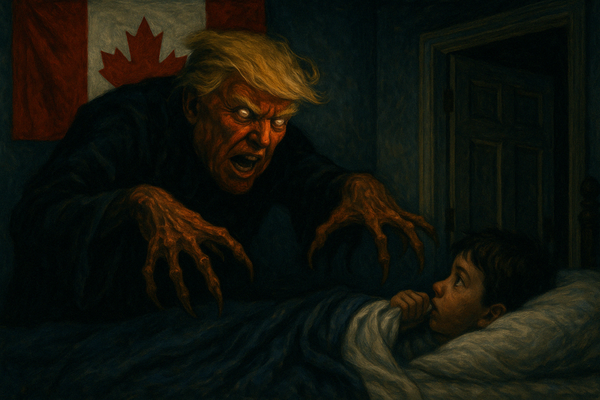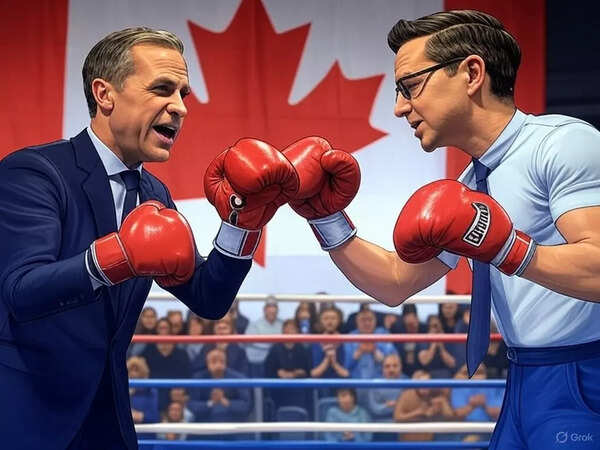It seems that philosophy is what is supposedly shaping voter behavior in an increasingly polarized American election landscape, not policy. A new National Post poll found a stark emotional disconnect between Conservative and Liberal voters, with 75 % of those who support economic growth, lower taxes, and social change as their main motivators, especially given Donald Trump’s threats to Canada’s sovereignty and industry.
Appointed Liberal leader Mark Carney doubles down on instructions of a Trump-dominated North America, while Conservative challenger Pierre Poilievre lays out a vision of renewal and regional confidence. This fear-versus-hope tale is being played out at the highest levels of management.
Trump as the Bogeyman: Carney’s Anxiety Strategy

One thing Mark Carney has made clear since taking over the Liberal Party’s leadership in March 2025 with an enormous 85.9 % inside ballot: the road to success in Canada perhaps then go through Washington. His campaign speeches are full of gloomy instructions about Donald Trump’s second-term plans, from threats to devastate the USMCA to rhetoric about making Canada the “51st state.”
The anxiety information is persisted in regions like Quebec. In this election, 40 % of Quebecois voters cited anxiety as their main emotional vehicle, compared to 40 % who said desire. Carney purposefully positions himself as the last barrier between American sovereignty and National intrusion, despite the narrowness of the distinction.
Social researcher Léa Moreau claims that Carney is using this election as a referendum on Canadian independence. By utilizing Trump, he hopes to win over the moderate and liberal voters, particularly in urban centers like Montreal and Toronto.
However, Carney’s plan is perceived as more of a federal vision than a seminar on crisis management, according to critics. His advantage is shrinking despite leading the Liberals to 43 % in the polls, with Conservatives closing the gap to 38 %, a 1 % increase over the previous week.
Poilievre’s Hope Offensive: The Enthusiasm Plan

Pierre Poilievre, in comparison, is spearheading what might be the most physically charged campaign in recent memory. His information? safer roads, lower fees, and a” believes Canadians more than it taxes them” government But most of all, trust.
Hope is regarded as the main motivating factor in the National Post ballot, which is far higher than anything that has been observed in new American elections.
Next year, Poilievre recited a statement to a group in Vaughan,” The Liberal Party wants you to get afraid.” Fearful of change, fearful of liberty, and fear of Trump. However, I think Canada may do much. I think you could accomplish much.
His group’s communication is primarily focused on economic independence and optimism, especially in crucial Ontario battlegrounds like the GTA, London, and Hamilton. The strategy photos show happy families, busy construction sites, and prosperity-themed maple leaf emblazoned homes.
It’s working, at least for the moment. The Conservatives ‘ steady increase in the polls is especially evident in voters from the suburban middle class, many of whom feel squeezed by rising mortgage costs and sluggish wages. Carney’s horrific develop may not be appropriate for them.
Trump in the Rearview and Windshield on The US Issue
Donald Trump remains the elephant in the room, or more, the eagle. His re-election in 2024 has left a long lasting impression on American elections. Trump has provided Carney with a convenient villain and Poilievre with a challenging issue, from threatening tariffs to making the casualty of a” continental consolidation.”
The center-left leans toward nationalism in a social rotation of the typical Canadian-American dynamic, while the right talks about cross-border assistance.
Carney is not a populist, but he is extremely reversing nationalist themes in his fight for democratic politics. His previous positions include governor of the Bank of Canada and after the Bank of England.
Poilievre, in contrast, may move a line: appearing patriotic while no antagonizing Trump, whose unpredictable unpredictability could stifle markets and derail any upcoming Traditional trade strategy.
” It’s a bizarre role reversal,” says teacher Althea Gagnon from the University of Toronto. Liberals “promote financial rationality,” while conservatives “waving the flag and invoking independence.” It’s 1984—but in slow”.
What to Enjoy: The Emotional Center of Ontario
The psychological ring is in Ontario, where Quebec and Alberta are generally spoken for. The Greater Toronto Area’s election will likely be decided by the election’s outcome, which will probably include its mixture of immigrant neighborhoods, swing ridings, and financial anxieties.
The mental breakdown here is similar to what is prevalent across the country: enthusiasm vs. concern, and hope vs. anxiety. What emotion may entice individuals to cast ballots?
Carney’s dread charm has so far tended to be drawing older citizens and steadfast Democratic supporters. However, Poilievre’s message is finding to be amazingly persuasive among younger, first-time citizens seeking change, especially those who are burdened by debts and despair.
Final Word: A Battle of Feelings versus Facts
The 2025 election in Canada is shaping up to be a referendum on emotion in a nation known for moderation and policy debates. The Liberals will cross the finish line, according to Carney, who is betting on fear of a Trump-dominated future. Poilievre hopes that his Conservatives ‘ optimism and a dash of righteous anger will win the party. One thing is clear as Canadians turn to the polls later this year: this election is less about policy platforms and more about how each side views the future. And in a political era where emotions are the only thing that matters, they might not even be.




